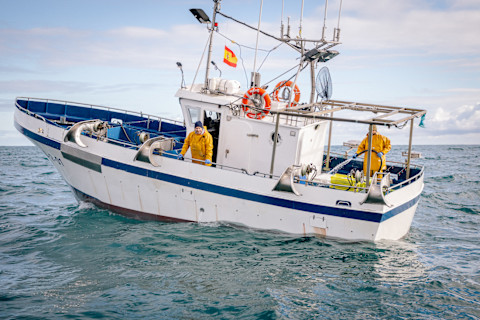The Sustainable (And Mediterranean-Diet-Approved) Protein Your Dinner Is Missing
When you spot something on the menu of three very trendy NYC restaurants over the course of a month, you know it's having a moment. When that thing is sardines served straight from the tin, you scratch your head and wonder, "What?" But then, when you take a bite of the salty decadence, it starts to make a little more sense. And once you consider that eating small fish like these could support healthier oceans, you sop up every last morsel and order seconds.
Why tinned fish tends to be a sustainable option.
Many things under the sun can be canned. The method was invented in France in 1810 to extend foods' shelf life, but it started to fall out of style as a way to preserve fish once more advanced freezing technology and transportation came around. These days, though, cans of smaller critters like mackerel, clams, mussels, sardines, and anchovies are making a comeback, and the global market for canned fish is expected to grow to $27.8 billion by 2025. It's like the process of canning makes these more abundant but less popular fish more palatable, which can actually be a great thing for our oceans.
Though overfishing rates in U.S. waters have actually dropped recently thanks to stricter regulations, globally we're still plucking more fish out of the ocean than can be replenished naturally. According to a 2018 report by the U.N., 33% of the world's marine populations are currently overfished, and nearly 60% are at max capacity. Only 7% are being underfished. Unsurprisingly, the species whose futures are threatened by overfishing are the ones we love to eat the most—your salmons, tunas, halibuts, and the like—while smaller fish populations are less likely to be tapped out.
Eating seafood that's lower on the food chain can take pressure off of larger threatened species and boost ocean health as a whole. In nature, everything is interconnected, and when one species begins to decline, the entire ecosystem feels it in some way. That's one reason Patagonia Provisions, the food arm of outdoor retailer Patagonia, chose to release its own line of tinned mackerel late last year.

"The big thing for our seafood line is to highlight the fact that we have to fish differently and really look at the ocean as something that is in direct need of restoration," Birgit Cameron, the company's managing director, tells mbg. "People are starting to realize that this poor tuna can't sustain everybody, and there are other alternatives that are really wonderful and can be great substitutes."
Beyond being a more sustainable swap for canned tuna fish or filets of larger fish, small canned fish are rich in protein1; vitamins B12, D and A; and omega-3s (especially when they're preserved in high-quality olive oil). By the nature of their place on the food chain, smaller fish are also less likely to contain mercury and other pollutants, which accumulate with each feeding in a process called biomagnification.
Tinned fish can stay fresh for up to seven years, which means that people have plenty of time to take advantage of these nutritional benefits. The health, convenience, and sustainability of tinned fish are reason enough to give the protein source a try. If you're a flexitarian who already swaps out the occasional hamburger for a veggie patty, why not switch up your usual fish order next?
I'll give it a try—but how do I make it taste good?
High-quality tinned fish doesn't need much doctoring to taste delicious. Once you find a fish variety that speaks to you (mackerel tends to be the most mild and is a nice starter option for the canned-fish unacquainted), you can pair it with veggies and crackers for a midday pick-me-up, use it as a salad on protein, or plop it on a bowl of pasta. Rick Moonen, the celebrity chef behind RM Seafood, previously told mbg that his go-to preparation for canned sardines is to sauté them with some sun-dried tomatoes, capers, and spinach, then serve over crusty bread.
Alex Raij, the James Beard recognized chef and owner of four Spanish-inspired restaurants in NYC, is partial to straining off the can's oils and saving them for the base of a salad dressing, then serving the remaining fish with vinegar-soaked onions and fresh herbs. "You can also flake the fish into a tart shell, mix it with a little aioli made from its oil, and breadcrumbs, and bake until browned," she says. Clearly, the sky (sea?) is the limit for this low-maintenance protein.
Quick tips for identifying the high-quality stuff.
Here are some things to look out for when you're buying tinned fish to make sure it was caught sustainably and then preserved in a healthy, delicious way:
- When you open the can, there's a whole filet inside: This is a good sign that the fish is minimally processed and nutrient-dense.
- It's preserved in olive oil: Heart-healthy olive oil is less inflammatory than alternatives like grapeseed oil and more flavorful than water.
- It was line-caught: Catching fish using a line leads to less bycatch (fish that are caught accidentally and left to die) than net fishing does. Some canned fish brands championing line-catching include the aforementioned Patagonia Provisions, Wild Planet, Bar Harbor, and Safe Catch.
- It's a fish population that is healthy and abundant: Small fish can be overharvested too! Be sure to check the Monterey Bay Aquarium's Seafood Watch database, an up-to-date look at the seafood stocks that are the most and least threatened around the world, before buying.
- It costs more than $1: Canned fish is affordable, but a can that's too cheap is probably not the best quality. Look for options that are in the $4 to $9 range, and if you're willing to splurge into the double digits, Chef Raij recommends Cuca and Don Bocarte.
